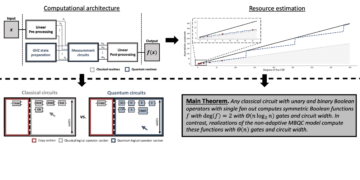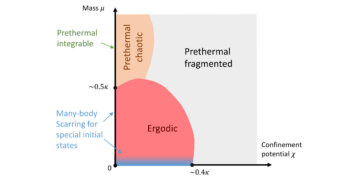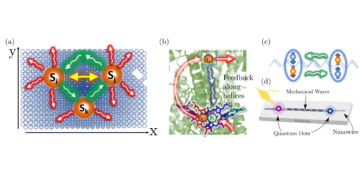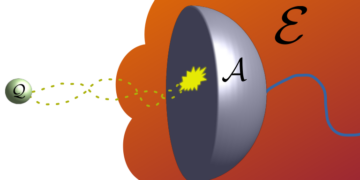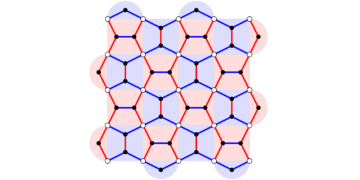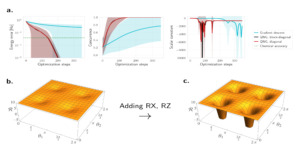1Física Teòrica: Informació i Fenòmens Quàntics, Departament de Física, Universitat Autònoma de Barcelona, 08193 Bellaterra, Spain.
2Scuola Normale Superiore, I-56127 Pisa, Italy.
3NEST, Scuola Normale Superiore and Istituto Nanoscienze-CNR, I-56127 Pisa, Italy.
Find this paper interesting or want to discuss? Scite or leave a comment on SciRate.
Abstract
We study the problem of testing identity of a collection of unknown quantum states given sample access to this collection, each state appearing with some known probability. We show that for a collection of $d$-dimensional quantum states of cardinality $N$, the sample complexity is $O(sqrt{N}d/epsilon^2)$, with a matching lower bound, up to a multiplicative constant. The test is obtained by estimating the mean squared Hilbert-Schmidt distance between the states, thanks to a suitable generalization of the estimator of the Hilbert-Schmidt distance between two unknown states by Bădescu, O’Donnell, and Wright [13].

Featured image: Two settings to which our model applies. In a) independent sources produce a random number, Poisson distributed, of copies of a state in a time $T$. In b), a measurement procedure prepares labeled states, each label appearing with some probability.
► BibTeX data
► References
[1] Gerardo Adesso, Thomas R. Bromley, and Marco Cianciaruso, “Measures and applications of quantum correlations” Journal of Physics A: Mathematical and Theoretical 49, 473001 (2016).
https://doi.org/10.1088/1751-8113/49/47/473001
arXiv:1605.00806
[2] Jayadev Acharya, Ibrahim Issa, Nirmal V. Shende, and Aaron B. Wagner, “Estimating Quantum Entropy” IEEE Journal on Selected Areas in Information Theory 1, 454–468 (2020).
https://doi.org/10.1109/JSAIT.2020.3015235
https://ieeexplore.ieee.org/document/9163139/
[3] Jayadev Acharyaand Constantinos Daskalakis “Testing Poisson Binomial Distributions” Proceedings of the Twenty-Sixth Annual ACM-SIAM Symposium on Discrete Algorithms 1829–1840 (2015).
https://doi.org/10.1137/1.9781611973730.122
arXiv:1507.05952
[4] Daiki Akimotoand Masahito Hayashi “Discrimination of the change point in a quantum setting” Physical Review A 83, 052328 (2011).
https://doi.org/10.1103/PhysRevA.83.052328
arXiv:1102.2555
[5] Robert Alicki, Slawomir Rudnicki, and Slawomir Sadowski, “Symmetry properties of product states for the system of N n-level atoms” Journal of Mathematical Physics 29, 1158–1162 (1988).
https://doi.org/10.1063/1.527958
[6] Ge Bai, Ya-Dong Wu, Yan Zhu, Masahito Hayashi, and Giulio Chiribella, “Quantum causal unravelling” npj Quantum Information 8, 69 (2022).
https://doi.org/10.1038/s41534-022-00578-4
arXiv:2109.13166
[7] Tuğkan Batu, Eldar Fischer, Lance Fortnow, Ravi Kumar, Ronitt Rubinfeld, and Patrick White, “Testing random variables for independence and identity” Proceedings 42nd IEEE Symposium on Foundations of Computer Science 442–451 (2001).
https://doi.org/10.1109/SFCS.2001.959920
https://ieeexplore.ieee.org/document/959920/
[8] Dave Bacon, Isaac L. Chuang, and Aram W. Harrow, “Efficient Quantum Circuits for Schur and Clebsch-Gordan Transforms” Physical Review Letters 97, 170502 (2006).
https://doi.org/10.1103/PhysRevLett.97.170502
arXiv:0407082
[9] Sebastien Bubeck, Sitan Chen, and Jerry Li, “Entanglement is Necessary for Optimal Quantum Property Testing” 2020 IEEE 61st Annual Symposium on Foundations of Computer Science (FOCS) 692–703 (2020).
https://doi.org/10.1109/FOCS46700.2020.00070
arXiv:2004.07869
[10] Charles H. Bennett, Igor Devetak, Aram W. Harrow, Peter W. Shor, and Andreas Winter, “The Quantum Reverse Shannon Theorem and Resource Tradeoffs for Simulating Quantum Channels” IEEE Transactions on Information Theory 60, 2926–2959 (2014).
https://doi.org/10.1109/TIT.2014.2309968
http://ieeexplore.ieee.org/document/6757002/
[11] E. Bagan, S. Iblisdir, and R. Muñoz-Tapia, “Relative states, quantum axes, and quantum references” Physical Review A 73, 022341 (2006).
https://doi.org/10.1103/PhysRevA.73.022341
arXiv:0508187
[12] Stéphane Boucheron, Gábor Lugosi, and Pascal Massart, “Concentration Inequalities” Oxford University Press (2013).
https://doi.org/10.1093/acprof:oso/9780199535255.001.0001
[13] Costin Bădescu, Ryan O’Donnell, and John Wright, “Quantum state certification” Proceedings of the 51st Annual ACM SIGACT Symposium on Theory of Computing 503–514 (2019).
https://doi.org/10.1145/3313276.3316344
arXiv:1708.06002
[14] Stephen D. Bartlett, Terry Rudolph, and Robert W. Spekkens, “Optimal measurements for relative quantum information” Physical Review A 70, 032321 (2004).
https://doi.org/10.1103/PhysRevA.70.032321
arXiv:0310009
[15] Harry Buhrman, Richard Cleve, John Watrous, and Ronald de Wolf, “Quantum Fingerprinting” Physical Review Letters 87, 167902 (2001).
https://doi.org/10.1103/PhysRevLett.87.167902
arXiv:0102001
[16] Clement L. Canonne “A Survey on Distribution Testing: Your Data is Big. But is it Blue?” Theory of Computing 1, 1–100 (2020).
https://doi.org/10.4086/toc.gs.2020.009
http://www.theoryofcomputing.org/articles/gs009
[17] Siu-On Chan, Ilias Diakonikolas, Paul Valiant, and Gregory Valiant, “Optimal Algorithms for Testing Closeness of Discrete Distributions” Proceedings of the Twenty-Fifth Annual ACM-SIAM Symposium on Discrete Algorithms 1193–1203 (2014).
https://doi.org/10.1137/1.9781611973402.88
arXiv:1308.3946
[18] Matthias Christandl “The Structure of Bipartite Quantum States – Insights from Group Theory and Cryptography” (2006).
arXiv:0604183
[19] Sitan Chen, Jerry Li, and Ryan O’Donnell, “Toward Instance-Optimal State Certification With Incoherent Measurements” Proceedings of Thirty Fifth Conference on Learning Theory 178, 2541–2596 (2022) https://proceedings.mlr.press/v178/chen22b.html.
arXiv:2102.13098
[20] Thomas M. Coverand Joy A. Thomas “Elements of Information Theory” (2005).
https://doi.org/10.1002/047174882X
[21] Ilias Diakonikolasand Daniel M. Kane “A New Approach for Testing Properties of Discrete Distributions” 2016 IEEE 57th Annual Symposium on Foundations of Computer Science (FOCS) 685–694 (2016).
https://doi.org/10.1109/FOCS.2016.78
arXiv:1601.05557
http://ieeexplore.ieee.org/document/7782983/
[22] Ilias Diakonikolas, Daniel M. Kane, and Vladimir Nikishkin, “Testing Identity of Structured Distributions” Proceedings of the Twenty-Sixth Annual ACM-SIAM Symposium on Discrete Algorithms 2015-Janua, 1841–1854 (2015).
https://doi.org/10.1137/1.9781611973730.123
[23] M. Fanizza, M. Rosati, M. Skotiniotis, J. Calsamiglia, and V. Giovannetti, “Beyond the Swap Test: Optimal Estimation of Quantum State Overlap” Physical Review Letters 124, 060503 (2020).
https://doi.org/10.1103/PhysRevLett.124.060503
arXiv:1906.10639
[24] Marco Fanizza, Christoph Hirche, and John Calsamiglia, “Ultimate Limits for Quickest Quantum Change-Point Detection” Phys. Rev. Lett. 131, 020602 (2023).
https://doi.org/10.1103/PhysRevLett.131.020602
arXiv:2208.03265
[25] Marco Fanizza, Farzad Kianvash, and Vittorio Giovannetti, “Quantum Flags and New Bounds on the Quantum Capacity of the Depolarizing Channel” Physical Review Letters 125, 020503 (2020).
https://doi.org/10.1103/PhysRevLett.125.020503
arXiv:1911.01977
[26] Marco Fanizza, Farzad Kianvash, and Vittorio Giovannetti, “Estimating Quantum and Private Capacities of Gaussian Channels via Degradable Extensions” Phys. Rev. Lett. 127, 210501 (2021).
https://doi.org/10.1103/PhysRevLett.127.210501
arXiv:2103.09569
[27] N. Gisinand S. Iblisdir “Quantum relative states” The European Physical Journal D 39, 321–327 (2006).
https://doi.org/10.1140/epjd/e2006-00097-y
arXiv:0507118
[28] Oded Goldreich “Introduction to Property Testing” Cambridge University Press (2017).
https://doi.org/10.1017/9781108135252
[29] Oded Goldreichand Dana Ron “On Testing Expansion in Bounded-Degree Graphs” (2011).
https://doi.org/10.1007/978-3-642-22670-0_9
[30] Jeongwan Haah, Aram W. Harrow, Zhengfeng Ji, Xiaodi Wu, and Nengkun Yu, “Sample-optimal tomography of quantum states” IEEE Transactions on Information Theory 63, 1–1 (2017).
https://doi.org/10.1109/TIT.2017.2719044
arXiv:1508.01797
http://ieeexplore.ieee.org/document/7956181/
[31] Aram W. Harrow “Applications of coherent classical communication and the Schur transform to quantum information theory” (2005).
arXiv:0512255
[32] Masahito Hayashi, Bao-Sen Shi, Akihisa Tomita, Keiji Matsumoto, Yoshiyuki Tsuda, and Yun-Kun Jiang, “Hypothesis testing for an entangled state produced by spontaneous parametric down-conversion” Phys. Rev. A 74, 062321 (2006).
https://doi.org/10.1103/PhysRevA.74.062321
[33] Masahito Hayashi “A Group Theoretic Approach to Quantum Information” Springer International Publishing (2017).
https://doi.org/10.1007/978-3-319-45241-8
[34] Masahito Hayashi “Group Representation for Quantum Theory” Springer International Publishing (2017).
https://doi.org/10.1007/978-3-319-44906-7
[35] Masahito Hayashi “Quantum Information Theory” Springer Berlin Heidelberg (2017).
https://doi.org/10.1007/978-3-662-49725-8
[36] Masahito Hayashiand Keiji Matsumoto “Quantum universal variable-length source coding” Physical Review A 66, 022311 (2002).
https://doi.org/10.1103/PhysRevA.66.022311
arXiv:0202001
[37] Masahito Hayashiand Marco Tomamichel “Correlation detection and an operational interpretation of the Rényi mutual information” Journal of Mathematical Physics 57, 102201 (2016).
https://doi.org/10.1063/1.4964755
arXiv:1408.6894
[38] Masahito Hayashi, Akihisa Tomita, and Keiji Matsumoto, “Statistical analysis of testing of an entangled state based on the Poisson distribution framework” New Journal of Physics 10, 043029 (2008).
https://doi.org/10.1088/1367-2630/10/4/043029
[39] L. Hendersonand V. Vedral “Classical, quantum and total correlations” Journal of Physics A: Mathematical and General 34, 6899–6905 (2001).
https://doi.org/10.1088/0305-4470/34/35/315
arXiv:0105028
[40] M. Keyl “Quantum state estimation and large deviations” Reviews in Mathematical Physics 18, 19–60 (2006).
https://doi.org/10.1142/S0129055X06002565
[41] Farzad Kianvash, Marco Fanizza, and Vittorio Giovannetti, “Bounding the quantum capacity with flagged extensions” Quantum 6, 647 (2022).
https://doi.org/10.22331/q-2022-02-09-647
arXiv:2008.02461
[42] Martin Klieschand Ingo Roth “Theory of Quantum System Certification” PRX Quantum 2, 010201 (2021).
https://doi.org/10.1103/PRXQuantum.2.010201
arXiv:2010.05925
[43] Hari Krovi “An efficient high dimensional quantum Schur transform” Quantum 3, 122 (2019).
https://doi.org/10.22331/q-2019-02-14-122
arXiv:1804.00055
https://quantum-journal.org/papers/q-2019-02-14-122/
[44] M. Keyland R. F. Werner “Estimating the spectrum of a density operator” Physical Review A 64, 052311 (2001).
https://doi.org/10.1103/PhysRevA.64.052311
arXiv:0102027
[45] Lucien Le Cam “An approximation theorem for the Poisson binomial distribution.” Pacific Journal of Mathematics 10, 1181–1197 (1960).
[46] Felix Leditzky, Nilanjana Datta, and Graeme Smith, “Useful States and Entanglement Distillation” IEEE Transactions on Information Theory 64, 4689–4708 (2018).
https://doi.org/10.1109/TIT.2017.2776907
arXiv:1701.03081
[47] Erich L Lehmannand Joseph P Romano “Testing statistical hypotheses” Springer Science & Business Media (2006).
[48] Reut Levi, Dana Ron, and Ronitt Rubinfeld, “Testing Properties of Collections of Distributions” Theory of Computing 9, 295–347 (2013).
https://doi.org/10.4086/toc.2013.v009a008
https://theoryofcomputing.org/articles/v009a008
[49] Netanel H. Lindner, Petra F. Scudo, and Dagmar Bruß, “Quantum estimation of relative information” International Journal of Quantum Information 4, 131–149 (2006).
https://doi.org/10.1142/S0219749906001657
arXiv:0506223
[50] Ashley Montanaroand Ronald de Wolf “A survey of quantum property testing” Theory of Computing 1, 1–81 (2016).
https://doi.org/10.4086/toc.gs.2016.007
arXiv:1310.2035
http://www.theoryofcomputing.org/articles/gs007
[51] Ryan O’Donnelland John Wright “Quantum Spectrum Testing” Proceedings of the forty-seventh annual ACM symposium on Theory of Computing 14-17-June, 529–538 (2015).
https://doi.org/10.1145/2746539.2746582
arXiv:1501.05028
[52] Ryan O’Donnelland John Wright “Efficient quantum tomography” Proceedings of the forty-eighth annual ACM symposium on Theory of Computing 19-21-June, 899–912 (2016).
https://doi.org/10.1145/2897518.2897544
arXiv:1508.01907
[53] Ryan O’Donnelland John Wright “Efficient quantum tomography II” Proceedings of the 49th Annual ACM SIGACT Symposium on Theory of Computing 962–974 (2017).
https://doi.org/10.1145/3055399.3055454
arXiv:1612.00034
[54] Harold Ollivierand Wojciech H Zurek “Quantum Discord: A Measure of the Quantumness of Correlations” Physical Review Letters 88, 017901 (2001).
https://doi.org/10.1103/PhysRevLett.88.017901
arXiv:0105072
[55] Liam Paninski “A Coincidence-Based Test for Uniformity Given Very Sparsely Sampled Discrete Data” IEEE Transactions on Information Theory 54, 4750–4755 (2008).
https://doi.org/10.1109/TIT.2008.928987
http://ieeexplore.ieee.org/document/4626074/
[56] Gael Sentís, John Calsamiglia, and Ramon Munoz-Tapia, “Exact Identification of a Quantum Change Point” Physical Review Letters 119 (2017).
https://doi.org/10.1103/PhysRevLett.119.140506
arXiv:1707.07769
[57] Gael Sentís, Emilio Bagan, John Calsamiglia, Giulio Chiribella, and Ramon Munoz-Tapia, “Quantum change point” Physical Review Letters 117 (2016).
https://doi.org/10.1103/PhysRevLett.117.150502
arXiv:1605.01916
[58] Gael Sentís, Esteban Martínez-Vargas, and Ramon Muñoz-Tapia, “Online strategies for exactly identifying a quantum change point” Physical Review A 98, 052305 (2018).
https://doi.org/10.1103/PhysRevA.98.052305
arXiv:1802.00280
[59] Graeme Smith, John A. Smolin, and Andreas Winter, “The quantum capacity with symmetric side channels” IEEE Transactions on Information Theory 54, 4208–4217 (2008).
https://doi.org/10.1109/TIT.2008.928269
arXiv:0607039
[60] Igal Sasonand Sergio Verdu “$f$ -Divergence Inequalities” IEEE Transactions on Information Theory 62, 5973–6006 (2016).
https://doi.org/10.1109/TIT.2016.2603151
arXiv:1508.00335
https://ieeexplore.ieee.org/document/7552457/
[61] Gregory Valiantand Paul Valiant “An Automatic Inequality Prover and Instance Optimal Identity Testing” 2014 IEEE 55th Annual Symposium on Foundations of Computer Science 51–60 (2014).
https://doi.org/10.1109/FOCS.2014.14
https://ieeexplore.ieee.org/document/6978989/
[62] Xin Wang “Pursuing the fundamental limits for quantum communication” IEEE Transactions on Information Theory 67, 4524–4532 (2021).
https://doi.org/10.1109/TIT.2021.3068818
arXiv:1912.00931
https://ieeexplore.ieee.org/document/9386074/
[63] Nengkun Yu “Sample Efficient Identity Testing and Independence Testing of Quantum States” 12th Innovations in Theoretical Computer Science Conference (ITCS 2021) 185, 11:1–11:20 (2021).
https://doi.org/10.4230/LIPIcs.ITCS.2021.11
arXiv:1904.03218
https://drops.dagstuhl.de/opus/volltexte/2021/13550
[64] Nengkun Yu “Almost Tight Sample Complexity Analysis of Quantum Identity Testing by Pauli Measurements” IEEE Transactions on Information Theory 69, 5060–5068 (2023).
https://doi.org/10.1109/TIT.2023.3271206
arXiv:2009.11518
Cited by
[1] Li Gao and Nengkun Yu, “Sample optimal tomography of quantum Markov chains”, arXiv:2209.02240, (2022).
[2] Marco Fanizza, Michalis Skotiniotis, John Calsamiglia, Ramon Muñoz-Tapia, and Gael Sentís, “Universal algorithms for quantum data learning”, EPL (Europhysics Letters) 140 2, 28001 (2022).
The above citations are from SAO/NASA ADS (last updated successfully 2023-09-13 12:15:38). The list may be incomplete as not all publishers provide suitable and complete citation data.
On Crossref’s cited-by service no data on citing works was found (last attempt 2023-09-13 12:15:37).
This Paper is published in Quantum under the Creative Commons Attribution 4.0 International (CC BY 4.0) license. Copyright remains with the original copyright holders such as the authors or their institutions.
- SEO Powered Content & PR Distribution. Get Amplified Today.
- PlatoData.Network Vertical Generative Ai. Empower Yourself. Access Here.
- PlatoAiStream. Web3 Intelligence. Knowledge Amplified. Access Here.
- PlatoESG. Automotive / EVs, Carbon, CleanTech, Energy, Environment, Solar, Waste Management. Access Here.
- PlatoHealth. Biotech and Clinical Trials Intelligence. Access Here.
- ChartPrime. Elevate your Trading Game with ChartPrime. Access Here.
- BlockOffsets. Modernizing Environmental Offset Ownership. Access Here.
- Source: https://quantum-journal.org/papers/q-2023-09-11-1105/
- :is
- :not
- ][p
- $UP
- 001
- 1
- 10
- 11
- 12
- 125
- 12th
- 13
- 14
- 15%
- 16
- 17
- 178
- 19
- 20
- 2000
- 2001
- 2005
- 2006
- 2008
- 2009
- 2010
- 2011
- 2013
- 2014
- 2015
- 2016
- 2017
- 2018
- 2019
- 2020
- 2021
- 2022
- 2023
- 22
- 23
- 24
- 25
- 26
- 27
- 28
- 29
- 30
- 31
- 32
- 33
- 36
- 39
- 40
- 41
- 46
- 49
- 50
- 51
- 54
- 60
- 66
- 67
- 7
- 70
- 8
- 87
- 9
- 97
- 98
- a
- Aaron
- above
- ABSTRACT
- access
- ACM
- affiliations
- algorithms
- All
- an
- analysis
- and
- annual
- appearing
- applications
- applies
- approach
- ARE
- areas
- AS
- author
- authors
- Automatic
- AXES
- b
- barcelona
- based
- BE
- berlin
- between
- Big
- Block
- Blue
- bound
- bounds
- Break
- business
- but
- by
- cambridge
- capacities
- Capacity
- Certification
- chains
- chan
- change
- Channel
- channels
- Charles
- chen
- Coding
- COHERENT
- collection
- collections
- comment
- Commons
- Communication
- complete
- complexity
- computer
- computer science
- computing
- Conference
- constant
- copies
- copyright
- correlations
- cryptography
- Dana
- Daniel
- data
- Dave
- de
- Den
- density
- Detection
- discord
- discuss
- distance
- distributed
- distribution
- distributions
- document
- e
- each
- efficient
- entanglement
- Ether (ETH)
- European
- exactly
- expansion
- extensions
- fifth
- Fingerprinting
- flagged
- flags
- For
- found
- Foundations
- Framework
- from
- fundamental
- GAO
- ge
- General
- given
- graphs
- Group
- harold
- harvard
- High
- holders
- HTML
- http
- HTTPS
- i
- Identification
- identifying
- Identity
- IEEE
- ii
- image
- in
- independence
- independent
- inequalities
- Inequality
- information
- innovations
- insights
- instance
- institutions
- interesting
- International
- interpretation
- IT
- Italy
- JavaScript
- John
- journal
- known
- kumar
- Label
- large
- Last
- learning
- Leave
- li
- License
- limits
- List
- lower
- Marco
- Martin
- matching
- mathematical
- mathematics
- matthias
- max-width
- May..
- mean
- measure
- measurement
- measurements
- Media
- model
- Month
- mutual
- necessary
- New
- no
- number
- obtained
- of
- on
- open
- operational
- operator
- optimal
- or
- original
- our
- Oxford
- oxford university
- Pacific
- pages
- Paper
- patrick
- Paul
- Peter
- physical
- Physics
- plato
- Plato Data Intelligence
- PlatoData
- Point
- Prepares
- press
- private
- probability
- Problem
- procedure
- Proceedings
- produce
- Produced
- Product
- properties
- property
- provide
- published
- publisher
- publishers
- Publishing
- Quantum
- quantum information
- quickest
- R
- ramon
- random
- references
- relative
- remains
- representation
- resource
- reverse
- review
- Reviews
- Richard
- ROBERT
- RON
- Rosati
- Ryan
- s
- Science
- selected
- setting
- settings
- show
- side
- some
- Source
- Sources
- Spain
- Spectrum
- Squared
- State
- States
- statistical
- Stephen
- strategies
- structure
- structured
- Study
- style
- Successfully
- such
- suitable
- Survey
- swap
- Symposium
- system
- test
- Testing
- thanks
- that
- The
- their
- theoretical
- theory
- this
- time
- Title
- to
- tomography
- Total
- Transactions
- Transform
- transforms
- two
- under
- Universal
- university
- unknown
- updated
- URL
- variables
- very
- via
- volume
- W
- want
- was
- we
- which
- white
- Winter
- with
- Wolf
- works
- Wright
- wu
- year
- Your
- zephyrnet

